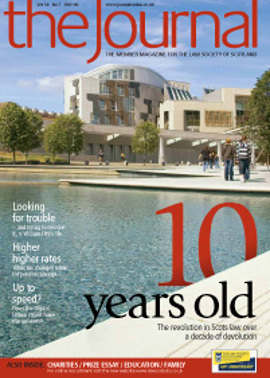Tread warily

If someone hangs a brass plaque outside their door proclaiming them to be a private client solicitor, you might have a reasonable idea of what to expect if you engage their services, but can the same thing be said about investment funds?
Many investors, whether private clients or trustees, are attracted to the idea of an investment that gives some exposure to the potential upside from equity markets while restricting the downside when markets crash. Given the market turmoil between 2000 and 2003, and the collapse of world stock markets from mid-2007 to date, it is not hard to see why investors would be attracted to such an idea.
To help investors compare funds, the Investment Management Association (IMA) groups similar funds into sectors. One sector which might appear to meet the needs of cautious investors needing long-term growth in excess of inflation is the Cautious Managed sector.
Diverse sector
There has been an explosion in the growth of Cautious Managed funds in recent years. The sector now includes 147 funds managing over £18 billion of client money, although this is heavily concentrated in a small number of big name funds. The top three funds in the sector control 25% of all assets, while the top 10 funds account for almost half of investors’ money.
Cautious Managed funds are certainly popular, but do they “do what they say on the tin”? Before answering this question, it is important to realise that every investor has a different definition of “cautious”. For example, one prudent trustee might deem a fall in capital value of less than 10% in any year to be acceptable in return for the real growth potential offered by some exposure to equities. They might be happy with a fund which invests no more than 50% of its assets in equities. Another trustee might deem any fall in value unacceptable.
Table 1 shows the average asset allocation between four major asset classes along with the highest and lowest weightings across the entire Cautious Managed sector.
You can see that there is a wide range of views on asset allocation within a single sector of supposedly similar funds. Two funds hold their entire portfolio in cash and fixed interest, while three funds hold only equities. One in 10 funds holds 70% of assets in cash and fixed interest. This would certainly seem consistent with a “cautious” mandate, but it may leave investors exposed to the risk of inflation, eroding purchasing power in the long run. The wide range of views on property is also worth noting, and surprisingly some funds disclosed a negative exposure to alternative assets. While 60% of funds have no exposure to hedge funds or structured products, 10% of funds hold a quarter of their portfolio in such assets.
Extremes of performance
There is considerable academic research to support the view that asset allocation is the biggest determinant of portfolio returns. With such a massive variance in asset allocations, it is hardly surprising that the range of returns has also been extreme. Table 2 shows the annual returns for discrete calendar years as well as the year to
31 May 2009. Along with the sector average, you can see the returns for the best and worst performing funds each year.
A number of points jump out of the table. First, the average Cautious Managed fund lost 15.8% in 2008, which seems quite a lot for a fund with a “cautious” mandate. This may give cause for concern for our fictitious trustee who viewed a 10% loss as the maximum acceptable. However, much more worryingly, the worst fund in the sector lost 37.4% of investors’ money. I am not sure which definition of “cautious” this manager was using but, considering that the FTSE All Share Index of UK equities only lost 29.9%, it certainly doesn’t seem cautious to me.
Secondly, the performance differential between the best and worst funds was 58.3% in 2008. This wasn’t an isolated incident either. The gap has been as high as 61.4% in the past, so funds in the Cautious Managed sector do not appear to be similar, and some are certainly not cautious.
Alternative focus
In an ideal world, trustees and their advisers would have been able to pick the best performing fund each year (or at least avoid the worst). Had a trustee invested £100,000 at the beginning of 1999 and been able to pick the best fund each year (ignoring the effect of costs and taxes), the trust fund would have grown to £718,970 by the end of 2008. However, had trustees invested in the worst fund each year they would have been left with just £27,850. Unfortunately, there is no reliable way of picking the winning funds and avoiding the losers. Trustees should focus their efforts on reducing fund management fees and controlling overall asset allocation, rather than trying to pick top performing funds.
Trustees should not assume that, just because a fund is categorised in the Cautious Managed sector (or has the word “cautious” in the title), it will provide stable low risk returns. Trustees need to dig beneath the surface and look at the underlying asset allocation if they are to fulfil their duty of care over the trust’s assets and protect themselves against disgruntled beneficiaries should the fund fail to perform as expected in future.
Alan Dick is a member of EBIS Group (Evidence Based Investment Solutions) and partner at Forty Two Wealth Management
In this issue
- Solicitor advocates: the future
- For the love of it
- Not to be denied
- Ten years on
- Never say never
- MD becomes new Keeper
- Whose view prevails?
- Scant relief?
- The greater good
- Twenty out of ten
- First class
- Clean break
- Ask Ash
- Not quite switched on
- Beware salary waiver tax traps
- Road to recovery?
- ASBOs: what standard?
- Scotland the unready
- The limits of listing
- Debt traps
- Tread warily
- Scottish Solicitors' Discipline Tribunal
- Website review
- Book reviews
- Procurement remedies take shape
- Clauses become more standard






